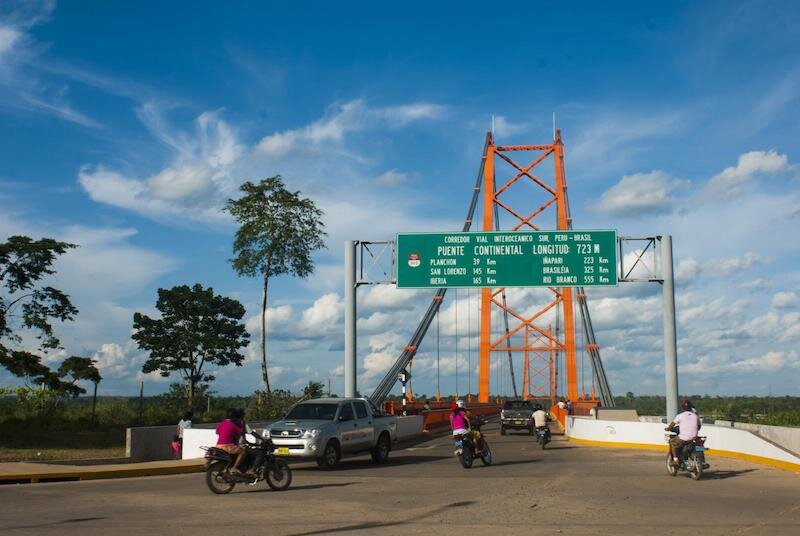A Guide To Puerto Maldonado
Located at 183 m (600 ft) above sea level, Puerto Maldonado is the largest city of the southern Amazon region, and the capital of the Department of Madre de Dios.
Close to the Bolivian border and astride the Inter-Oceanic Highway, this is a thriving market and transportation centre, as well as a government hub.
The Continental Bridge across the Madre de Dios River.
Completed in 2012, the Inter-Oceanic Highway was designed to link the river ports of Brazil with the Pacific coast ports of Peru, thereby giving Brazilian products a different point of exportation, closer to the Asian market.
The highway passes through Puerto Maldonado, crossing the Madre de Dios River on the 722 m (2,369 ft) Puente Continental (Continental Bridge).
While it has not had the impact on international commerce that was hoped for, it has reduced the journey from Cusco (memorably described in Matthew Parris’ travelogue Inca-Kola) from several days on unpaved roads … to around 8 hours.
The easier access, combined with the lure of panning for gold in the rivers that flow from the Andes mountains down into Madre de Dios, on their way to the Atlantic Ocean, has seen the population of Puerto Maldonado increase rapidly. In 2017, the official number was 85,000; now it is thought to be over 100,000.
Puerto Maldonado has always attracted immigrants from other parts of Peru. Founded in 1901, following exploration of the area by the famous rubber baron, Fitzcarrald, it was originally a rubber-collecting centre at the strategic confluence of the Madre de Dios and Tambopata rivers.
The name is in honour of the explorer Faustino Maldonado, who travelled the length of the Madre de Dios River to establish its course. He drowned when his boat overturned in rapids on the Mamoré River, in 1861.
Over the ensuing years, the economic opportunities of logging, gold and Brazil nuts have continued to attract migrants from the coast and Andes. Sadly the diseases they brought with them had a devastating effect on the many indigenous peoples of the area.
Puerto Maldonado has the official title of Capital of Biodiversity in Peru in recognition of the flora and fauna to be found in the forests of the surrounding department, especially in the protected areas of Tambopata-Candamo, Bahuaja-Sonene and Manu, which attract researchers, naturalists, birdwatchers and eco-tourists.
In fact, for most travelers, Puerto Maldonado is little more than a transit point between the airport or bus terminal and the nearby eco-lodges and nature reserves.
The clock tower in Puerto Maldonado’s Plaza de Armas.
For those who do spend time in the city, the Plaza de Armas with its trademark clock tower is worth a stroll, as is the main street (Calle Leon de Velarde), where several shops sell locally made hammocks and other rainforest trinkets.
Restaurants serve local dishes like patarashca (river fish steamed in banana leaves) and timbuche (fish soup).
A couple of blocks to the northeast of the plaza, the bustling riverside port area can be picturesque, especially at dusk and dawn when the water turns molten silver. Plaza Almirante Miguel Grau, next to the port, is a nice place to watch the sunset.
In the centre of town is a rather stark, concrete tower, called El Mirador de la Biodiversidad (The Biodiversity Lookout) which offers views over the city and surrounding jungle, plus local history exhibits.
There is another port on the Tambopata River, at the south end of town.
Heron with dragonfly in mouth, on Lake Sandoval, Puerto Maldonado.
The jungle starts right outside the city, with the trailhead to Lago Sandoval around half an hour by motorboat down the Madre de Dios River. The huge lake is a mecca for birdwatchers, but also a great place to spot caiman, capybara and giant otters in the swampy lakeside vegetation (aguajal).
Sandoval Lake Lodge, a joint venture between an international eco-tourism company and local Brazil nut farmers, crowns a bluff above the lake.
There are other well-respected lodges to be found downstream from Puerto Maldonado, on the Madre de Dios River; or continuing further, on the Heath River that marks the divide between Peru and Bolivia.
Even more lodges are to be found on the banks of the Tambopata River, upstream from Puerto Maldonado. These are reached by speedboat, although a dirt track has recently been cleared joining the the Inter-Oceanic Highway to the river, near the confluence with the Malinowski River. This has cut down journey times to remoter lodges, such as Tambopata Research Center.
How to visit Puerto Maldonado:
Even though the overland journey to Puerto Maldonado is considerably less taxing now, most visitors arrive by plane. There are several daily flights from Cusco (45 minutes) and Lima (2 hours, often via Cusco).
On arrival at Puerto Maldonado Airport, most are whisked off to their respective Amazon lodges, with only a short time spent in the city itself. But if you wish to spend some time getting to know a rapidly-changing jungle city; or your flight times necessitate an overnight, we can happily suggest places to stay and things to do. Just get in touch.
What our clients say about Puerto Maldonado:
“We are happy that we planned a night in Puerto Maldonado [at Wasai Puerto Maldonado EcoLodge].
It was a nice little city and we enjoyed some great food!”
“We ended up only staying 3 nights at Tambopata Research Center.
As much as we enjoyed the treks, we were exhausted from the heat and humidity (especially at night) and decided to spend a night in Puerto Maldonado.
We loved our over night there [at Copasu Hotel].”




